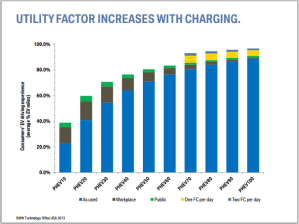As I left off in my previous blog about driving electric vehicles (EVs) around Norway, a big takeaway for me was the importance of an easily available and predictable system of charging infrastructure to the whole experience. The convenience of being able to charge – especially with a direct current fast charger – eases range anxiety and heightens the enjoyment of zipping around in any of today’s growing number of EVs, I discovered. Recent studies in California reveal even more benefits to growing the ecosystem of charging infrastructure and switching from gasoline to electricity.

Figure 1: Utility Factor represents the percentage of miles driven that are powered purely from the battery (rather than the gasoline engine). “PHEV10” stands for a plug-in hybrid capable of driving 10 miles in all-electric mode before switching to gasoline and operating as a charge-sustaining hybrid.
It turns out that more abundant charging stations also result in a cleaner emissions profile for plug-in hybrids (PHEV) – familiar cars like the Chevrolet Volt or Toyota Prius Plug-in, both of which couple a gasoline engine with a battery that can be plugged in and charged. Research from the folks at BMW’s Technology Office in Palo Alto demonstrates that, in actual practice, PHEV drivers achieve a significantly greater percentage of electric miles when you add public and workplace charging opportunities. As BMW’s Peter Dempster explained in a recent CBEY webinar (revisit A Future Vision for Sustainable E-mobility), the ability to use fast chargers is also a big boost to the “Utility Factor” (see Figure 1) of PHEVs. “We can increase the amount of all-electric miles of a plug-in hybrid or range-extended electric vehicle by up to 15% with workplace, public and fast charging opportunities.” As battery technology improves, charging infrastructure expands, and consumer behavior evolves, we grow much closer to meeting 100% of our mobility needs through domestically produced electricity.
The BMW Technology Office also found that drivers in their EV pilot study in California became much better “energy managers” in their own esteem. Participants reported increased awareness and savvy about their energy use through driving an EV, as they more viscerally experienced their electricity use, thought more about the source of their “fuel,” and could easily see how much power they were using. This kind of behavioral shift could certainly have spillover benefits into other areas of personal energy use, such as in the home.
Yet another interesting result from their research suggests that the growth in renewable energy and electric vehicles could be quite interconnected, as driving an EV seems to increase a consumer’s appetite for clean sources of electricity – whether from home solar or from the local utility. The potential parallel growth of electric cars and clean energy begs to be understood better, and these kinds of dynamics are being researched as I write, helping to further drive the transition to cleaner mobility.
Tommy Hayes is a second year student in the joint degree program between the Yale School of Forestry & Environmental Studies and the Yale School of Management.
